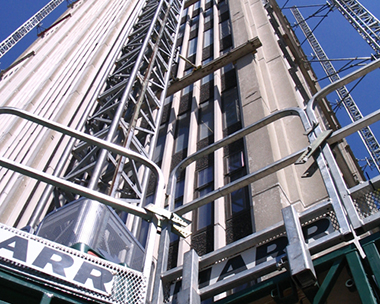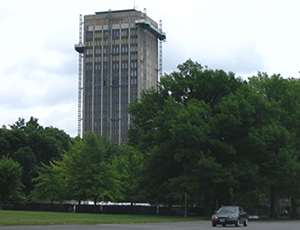Towering Above Most
 |
|
The Mohawk Tower renovation included the repairing and resealing of cast-concrete building ribs and the addition of energy-efficient, awning-style windows. |
ALBANY, N.Y. (Dec. 15, 2016) — When the University began a total overhaul of the 100,000-square-foot Mohawk Tower in 2012, reducing utility use and increasing comfort levels were high on the list of goals.
The work, which was completed in the fall of 2014, included replacing the original 1972 windows with energy-efficient, awning-style windows, repairing and resealing the cast-concrete building ribs, and adding insulation or, in some places, installing insulation for the first time. Lighting was upgraded, and the plumbing system was retrofitted with dual-flush toilets and metered faucets.
That work has been recognized, with Gold Level LEED Certification. Gold is the second-highest level of LEED certification, a third-party verification system for green buildings. LEED stands for Leadership in Energy and Environmental Design, and it assures that a building is resource-efficient, using less water and energy and reducing greenhouse gases. LEED buildings also take less money to operate.
“Mohawk Tower is the first high-rise residential tower on campus to get LEED certification,” said John Giarrusso, associate vice president of Finance & Administration. “Achieving LEED Gold on an existing building renovation project is a tremendous achievement given the envelope and historic preservation constraints.”
 |
|
Mohawk Tower during its 2012-14 renovation. |
Giarrusso said that vital to the success of the $39 million project were project manager Diana Delp, a senior architect on campus, construction manager Bob Morawski, and Indu, the University’s energy officer.
Indu said the result of the rehab is a building that uses 33 percent less energy than a similarly sized, code-compliant building. Water use is projected to be 40 percent lower because of the water-efficient fixtures. The project diverted more than half of construction waste from landfill by recycling, reusing, and salvaging materials.
Other highlights of the construction project:
- Mohawk Tower’s heat-recovery system improves ventilation while using less energy to heat outside air.
- More than 70 percent of the lumber in the project was Forest Stewardship Council approved, meaning it was sustainably grown or recycled.
- The project used 35 percent recycled material overall, as well low- emitting adhesives, sealants, paints, coating and flooring.
Mohawk Tower, which received its LEED certification on Nov. 30, joins other campus projects that have achieved the honor. Liberty Terrace, the Data Center and the Massry Center for Business all have LEED Gold status. Husted Hall, the RNA Institute and the SBA Annex all have been certified LEED Silver.
Giarrusso said the University strives to integrate energy efficiency and sustainability into all of its major renovation projects.
![]() For more news, subscribe to UAlbany's RSS headline feeds
For more news, subscribe to UAlbany's RSS headline feeds
A comprehensive public research university, the University at Albany-SUNY offers more than 120 undergraduate majors and minors and 125 master's, doctoral and graduate certificate programs. UAlbany is a leader among all New York State colleges and universities in such diverse fields as atmospheric and environmental sciences, business, education, public health,health sciences, criminal justice, emergency preparedness, engineering and applied sciences, informatics, public administration, social welfare and sociology, taught by an extensive roster of faculty experts. It also offers expanded academic and research opportunities for students through an affiliation with Albany Law School. With a curriculum enhanced by 600 study-abroad opportunities, UAlbany launches great careers.


